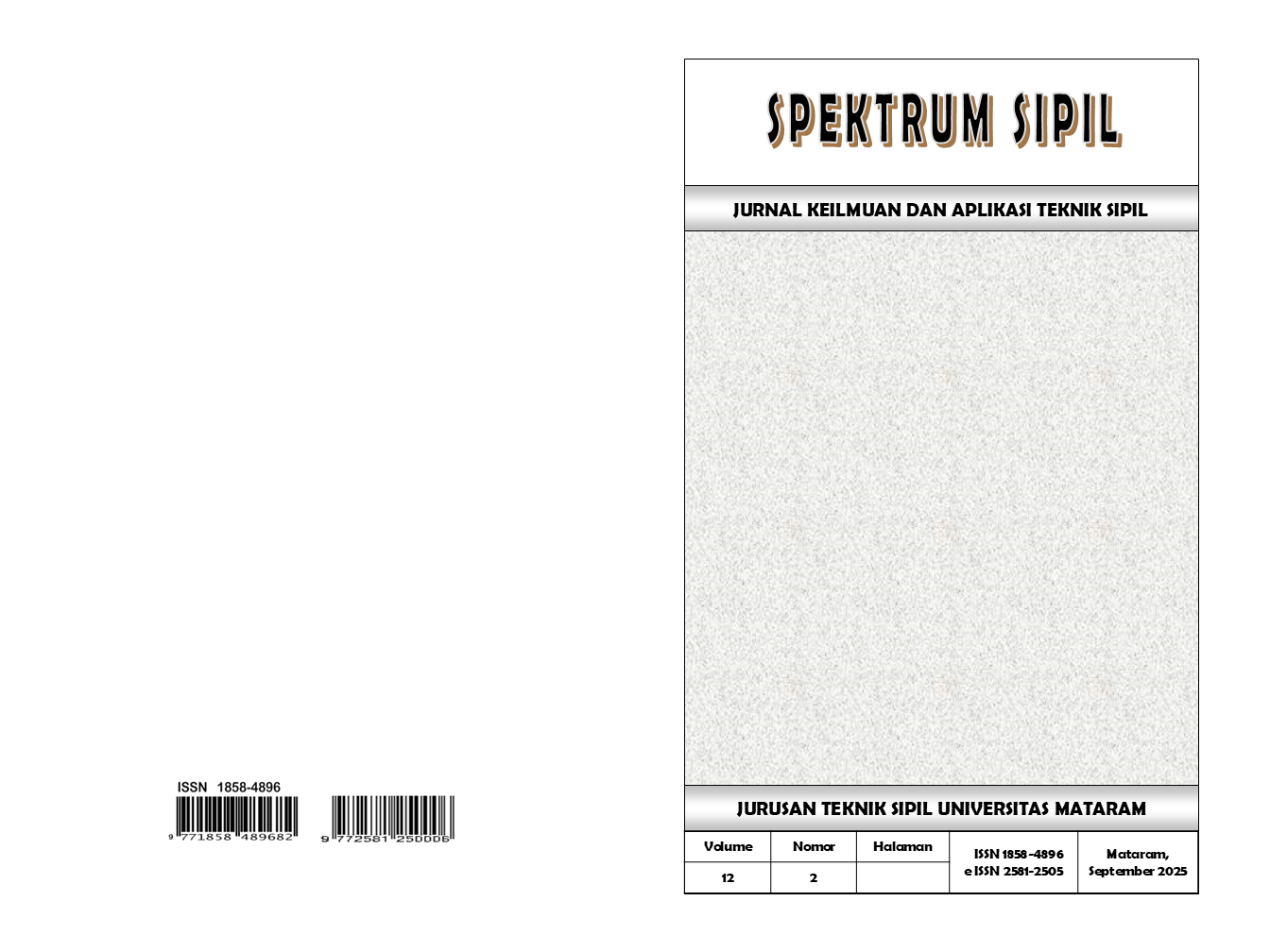VALIDASI EKSPERIMENTAL LABORATORIUM PERILAKU LENTUR STRUKTUR BALOK BETON SANDWICH TERHADAP PENGARUH TEMPERATUR TINGGI
Experimental Laboratory Validation Flexural Behavior of Sandwich Concrete Beams Under High Temperature Exposure
DOI:
10.29303/spektrum.v12i2.412Published:
2025-10-20Issue:
Vol. 12 No. 2 (2025): SPEKTRUM SIPILKeywords:
Balok beton, Sandwich, Temperatur, Tegangan, Kapasitas bebanArticles
Downloads
How to Cite
Downloads
Abstract
Concrete is a primary material widely used in structural elements due to its high compressive strength. However, concrete experiences a significant reduction in compressive strength when exposed to elevated temperatures. This study investigates the flexural behavior of normal and sandwich concrete beams subjected to high temperatures. Numerical modeling using ANSYS software was performed to validate laboratory experimental results. The analysis includes load-bearing capacity, stress distribution based on von Mises criteria, and beam deflection. The models consist of normal concrete and sandwich concrete beams with dimensions of 200×300×4000 mm. The compressive strength of normal concrete is 25 MPa, while the lightweight core concrete in the sandwich beam is 15 MPa, with a concrete cover of 20 mm. Reinforcement consists of 3Ø12 mm tensile bars and 2Ø12 mm compressive bars with a yield strength of 300 MPa. Two-point loads were applied symmetrically at one-third of the span from the supports. The results show that the load capacity of normal concrete beams at 20°C, 200°C, 400°C, 600°C, and 800°C are 18.982 kN, 10.899 kN, 8.361 kN, 5.059 kN, and 2.348 kN, respectively, whereas sandwich beams achieve 25.327 kN, 12.101 kN, 7.349 kN, 5.436 kN, and 3.354 kN. It can be concluded that sandwich concrete beams exhibit superior load-bearing stability at elevated temperatures compared to normal concrete beams.
Keywords: Concrete beam, Sandwich, Temperature, Stress, Load Capacity
References
Afrizal, Y. (2014). Analisis Kekuatan Beton Pascabakar Dengan Metode Numerik. Jurnal Teknosia Universitas Bengkulu.
Akmaluddin, A., Murtiadi, S., & Anshari, B. (2020). Flexural Stiffness of Normal and Sandwich Reinforced Concrete Beam Exposed to Fire Under Fixed Loading. International Review of Civil Engineering (IRECE), Vol. 11, No. 1, pp. 36-44. DOI: 10.15866/irece.v11i1.17550.
ANSYS Mechanical Academic Teaching Version (2025). License No. cc28aadbb66f, ISTN, Jakarta.
Adiguna., & Alkhamuddin, A. (2018). Simulasi Perubahan Kuat Tekan Beton pada Kondisi Ekstrim Pasca Pembakaran. Jurnal Deformasi Universitas PGRI Palembang.
Badan Standardisasi Nasional. (2019). SNI 2847-2019: Persyaratan Beton Struktural Untuk Bangunan Gedung. Badan Standarisasi Nasional (BSN), Jakarta.
CEN (2005). Eurocode 3: Design of Steel Structures – Part 1-2: General rules – Structural fire design (EN 1993-1-2). Brussels: European Committee for Standardization.
European Convention for Constructional Steelwork (ECCS). (2001). Fire Safety of Steel Structures: A Handbook. ECCS Technical Committee 3.
Fiana, L., Ngudiyono., Kencanawati, N., & Murtiadi, S. (2024). Modeling the Effect of Hole Diameter on Axial Capacity Columns Using ANSYS Software. SSRG International Journal of Civil Engineering.
Kodur, W. (2013). Effect of Temperature on Strength and Elastic Modulus of High-Strength Steel. Journal of Materials in Civil Engineering.
Murtiadi, S., & Akmaluddin, A. (2023). Performance of Concrete Building Structure Exposed to Localized Fire. Civil Engineering and Architecture 11(1): 114-122, 2023 http://www.hrpub.org. DOI: 10.13189/cea.2023.110110.
Murtiadi, S., Mahendra, M., Karyawan, I. D. M. A., Akmaluddin, A., & Pradjoko, E. (2023). Constitutive Model of Concrete Frame Structure under Localized Fire Simulations. Mandalika International Multiconference on Science and Engineering, MIMSE-C-A 2022, AER 215, pp. 65–75.
https://doi.org/10.2991/978-94-6463-088-6_8.
Nakasone, Y., Yoshimoto, S., & Stolarski, T.A. (2006). Engineering Analysis with ANSYS Software. Elsevier Butterworth-Heinemann, Linacre House, Jordan Hill, Oxford.
Pauw, A. (1960). Static Modulus of Elasticity of Concrete as Affected by Density. Journal of the American Concrete Institute, Vol. 57, No. December 1960.
Schneider, U. (1990). Behaviour of concrete at high temperatures. ACI Materials Journal, 87(2), 160–165.
Rao, S.K.P, & Tadepalli, T. (2024). High-Temperature Behaviour of Concrete: A Review. Conference: International Conference on Cement and Building Concrete for a Sustainable and Resilient Infrastructur, pp. 167-186, India. DOI:10.1007/978-981-99-7464-1_13.
Author Biographies
Vembri Affiano, Institut Sains dan Teknologi Nasional
Suryawan Murtiadi, Institut Sains dan Teknologi Nasional
Syahril Taufik, Institut Sains dan Teknologi Nasional
Akmaluddin Akmaluddin, Universitas Mataram
License
Copyright (c) 2025 Vembri Affiano, Suryawan Murtiadi, Syahril Taufik, Akmaluddin Akmaluddin

This work is licensed under a Creative Commons Attribution 4.0 International License.
You are free to:
- Share — copy and redistribute the material in any medium or format for any purpose, even commercially.
- Adapt — remix, transform, and build upon the material for any purpose, even commercially.
The licensor cannot revoke these freedoms as long as you follow the license terms.
Under the following terms:
- Attribution — You must give appropriate credit, provide a link to the license, and indicate if changes were made. You may do so in any reasonable manner, but not in any way that suggests the licensor endorses you or your use.
- No additional restrictions — You may not apply legal terms or technological measures that legally restrict others from doing anything the license permits.
Notices:
You do not have to comply with the license for elements of the material in the public domain or where your use is permitted by an applicable exception or limitation.
No warranties are given. The license may not give you all of the permissions necessary for your intended use. For example, other rights such as publicity, privacy, or moral rights may limit how you use the material.












